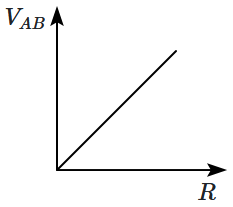Select Question Set:
All the resistances in the circuit shown below are \(2~\Omega.\) The equivalent resistance between \(A\) and \(C\) is:

1.
\(4~\Omega\)
2.
\(2~\Omega\)
3.
\(\dfrac43~\Omega\)
4.
\(\dfrac{10}3~\Omega\)
Subtopic: Combination of Resistors |
73%
Level 2: 60%+
Hints
The potential difference \(V_{AB}\) (in volts) is plotted as a function of the resistance \(R.\) The graph is given by:


| 1. |  |
2. |  |
| 3. |  |
4. |  |
Subtopic: Derivation of Ohm's Law |
52%
Level 3: 35%-60%
Hints
The current flowing through the left \(20~\Omega\) resistor is:


| 1. | \(1~\text A\) | 2. | \(0.5~\text A\) |
| 3. | \(2.5~\text A\) | 4. | \(3~\text A\) |
Subtopic: Kirchoff's Voltage Law |
59%
Level 3: 35%-60%
Hints
A \(20~\text V\) cell delivers the same power to a \(2~\Omega\) resistor as it does to an \(8~\Omega\) resistor. The internal resistance of the cell is:
1. \(2~\Omega\)
2. \(4~\Omega\)
3. \(6~\Omega\)
4. \(1.6~\Omega\)
1. \(2~\Omega\)
2. \(4~\Omega\)
3. \(6~\Omega\)
4. \(1.6~\Omega\)
Subtopic: Heating Effects of Current |
56%
Level 3: 35%-60%
Hints
Two cells having emfs \(3\) V and \(2\) V are connected in parallel and they give an emf of \(0.5\) V in the same sense as \(3\) V \(-\) cell. The internal resistances of the cells are \(r_1\) and \(r_2\) respectively. If one cell is reversed, their combined emf becomes \(2.5\) V. The ratio of their internal resistances \(\Big(\dfrac{r_1}{r_2}\Big) \) is:
1. \(1\)
2. \(\dfrac12\)
3. \(\dfrac21\)
4. \(\sqrt2\)
1. \(1\)
2. \(\dfrac12\)
3. \(\dfrac21\)
4. \(\sqrt2\)
Subtopic: Grouping of Cells |
67%
Level 2: 60%+
Hints
In the Wheatstone Bridge arrangement shown, the resistance \(P\) is \(2~ \Omega.\) The bridge is initially balanced. If P and Q are interchanged: an amount equal to \(S\) has to be added to \(R\) to restore the balance. The resistance \(Q\) equals (nearly):

1. \(2 ~\Omega\)
2. \(3.2 ~\Omega\)
3. \(4 ~\Omega\)
4. \(6.4 ~\Omega\)

1. \(2 ~\Omega\)
2. \(3.2 ~\Omega\)
3. \(4 ~\Omega\)
4. \(6.4 ~\Omega\)
Subtopic: Wheatstone Bridge |
Level 3: 35%-60%
Hints
Current density is the current crossing per unit area. Consider a cylindrical wire of uniform cross-section \(A,\) carrying a current \(I.\) Imagine a cross-section formed by a "\(30^\circ\)-cut" as shown (the wire is not really cut). The current density perpendicular to this cross-section is:


| 1. | \(\dfrac{I}{A}\) | 2. | \(\dfrac{I}{A}~\cos30^\circ\) |
| 3. | \(\dfrac{2I}{A}\) | 4. | \(\dfrac{I}{A}~\sin30^\circ\) |
Subtopic: Current & Current Density |
Level 3: 35%-60%
Hints
A thin circular conducting wire is connected at \(A,B\) where the smaller arc \(AB\) represents \(\dfrac14^{\text{th}}\) of the circumference. A current flows from \(A\) to \(B,\) dividing into two branches \(i_1\) and \(i_2\) at \(A.\) The ratio \(i_1:i_2\) equals:


| 1. | \(3\) | 2. | \(4\) |
| 3. | \(\dfrac13\) | 4. | \(1\) |
Subtopic: Combination of Resistors |
57%
Level 3: 35%-60%
Hints
Given below are two statements:
| Statement I: | Kirchhoff’s current law is a consequence of the conservation of energy as applied to electric circuits. |
| Statement II: | Kirchhoff’s voltage law is a consequence of the conservation of charge. |
| 1. | Statement I is incorrect and Statement II is correct. |
| 2. | Both Statement I and Statement II are correct. |
| 3. | Both Statement I and Statement II are incorrect. |
| 4. | Statement I is correct and Statement II is incorrect. |
Subtopic: Kirchoff's Voltage Law |
70%
Level 2: 60%+
Hints
The resistance between \(A,B\) is found to be \(500~\Omega\) while that between \(A,C\) is \(400~\Omega.\) The minimum possible value of \(R_2\) is:

1. \(100~\Omega\)
2. \(200~\Omega\)
3. \(400~\Omega\)
4. \(900~\Omega\)

1. \(100~\Omega\)
2. \(200~\Omega\)
3. \(400~\Omega\)
4. \(900~\Omega\)
Subtopic: Kirchoff's Voltage Law |
53%
Level 3: 35%-60%
Hints
Select Question Set:






